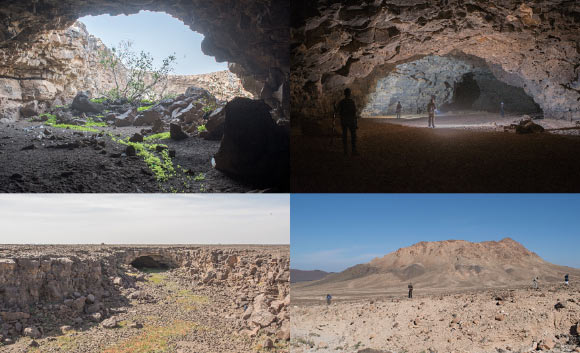New archaeological excavations have revealed repeated phases of human occupation of Umm Jirsan lava tube in the Harrat Khaybar, north-western Saudi Arabia, ranging from at least the Neolithic through to the Chalcolithic/Bronze Age (10,000-3,500 years ago).
Photographs of Umm Jirsan Cave and its interior sections. Image credit: Stewart et al., doi: 10.1371/journal.pone.0299292.
Intensified field research in northern Arabia over the last decade has highlighted the richness and diversity of the region’s archaeological and paleontological records.
Human occupation in northern Arabia during the Pleistocene was sporadic and seemingly linked to periods of improved climate, though by the Holocene people were able to more consistently settle the region through dry intervals.
“Our findings at Umm Jirsan provide a rare glimpse into the lives of ancient peoples in Arabia, revealing repeated phases of human occupation and shedding light on the pastoralist activities that once thrived in this landscape,” said Dr. Mathew Stewart, an archaeologist at Griffith University and the Max Planck Institutes of Geoanthropology.
“This site likely served as a crucial waypoint along pastoral routes, linking key oases and facilitating cultural exchange and trade.”
Rock art and faunal records attest to the pastoralist use of Umm Jirsan and surrounding areas, painting a vivid picture of ancient lifeways.
Depictions of cattle, sheep, goat and dogs corroborate the prehistoric livestock practices and herd composition of the region.
An isotopic analysis of animal remains from the lava tube indicates that livestock primarily grazed on wild grasses and shrubs, while humans maintained a diet rich in protein, with a notable increase in the consumption of C3 plants over time, suggesting the emergence of oasis agriculture.
“While underground localities are globally significant in archaeology and Quaternary science, our research represents the first comprehensive study of its kind in Saudi Arabia,” said Professor Michael Petraglia, an archaeologist at Griffith University, the University of Queensland and Smithsonian Institution.
The findings underscore the immense potential for interdisciplinary investigations in caves and lava tubes, offering a unique window into Arabia’s ancient past.
“Umm Jirsan was likely not a permanent home, but instead a valuable stopping point for people traveling between oasis settlements,” the authors said.
“Lava tubes and other natural shelters were valuable resources for communities surviving in a challenging environment, and with further investigation, they present a key source of archaeological information about the history of human occupation in Arabia.”
“Exploring Arabia’s hidden past, our study uncovers millennia of human occupation within and around the Umm Jirsan lava tube, shedding light on ancient lifestyles and adaptations to environmental change in this harsh desert environment.”
The team’s paper was published online in the journal PLoS ONE.
_____
M. Stewart et al. 2024. First evidence for human occupation of a lava tube in Arabia: The archaeology of Umm Jirsan Cave and its surroundings, northern Saudi Arabia. PLoS ONE 19 (4): e0299292; doi: 10.1371/journal.pone.0299292


